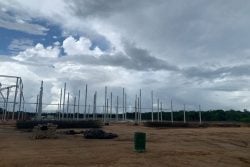By Dr. Leyland Lucas
Visiting Professor
School of Enterprise and Business Innovation
University of Guyana
As Guyana prepares for the flow of oil and gas in 2020, there is a great deal of discussion surrounding how this nation will benefit. Unfortunately, as this discussion occurs, much of the focus has been on the challenges linked to oil and gas exploration in a developing country. There is certainly reason for such concerns to be raised, as there is a wealth of evidence suggesting that the benefits may not outweigh the costs. As I write this article, there is overwhelming evidence that individual wealth often grows with the flow of oil and gas in developing countries. Unfortunately, the growth in individual wealth does not spread throughout the country and remains concentrated in the hands of a few. There are stories of enhanced wealth among the elite, absence of broad national development from the added revenue, and even suggestions of heightened corruption with the flow of oil and gas in these developing countries. This, coupled with the social upheaval and population shifts linked to the individual economic expectations from this industry provide further evidence around what could happen in Guyana. Whether or not we can protect ourselves from all that we have heard remains an open question.

As I listen to debates on the merits and boundaries of a local content policy, one question races through my mind: Do we understand the implications of such a policy and are we ready for it? Any discussions of local content policy must first acknowledge that it is multidimensional. The parts that must be involved in the design, monitoring, and implementation of such a policy cannot operate either independent of each other or irrespective of what others are doing. Local content policy has political, economic, social, and cultural implications. The rest of this essay seeks to present some of the challenges I see facing Guyana in pursuit of an effective local content policy.
One issue that must be immediately addressed is generating a clear understanding of what this local content policy is intended to accomplish. In some instances, this policy has helped to develop significant wealth, but nothing else can be seen. Tall structures are built, and numerous signs of ostentatious consumption are visible. Yet, when oil and gas prices decline, the entire nation catches a proverbial cold, in the face of already high levels of abject poverty. My point here is that, unless we look beyond the confines of immediate wealth creation and economic growth to economic development, local content policies will be ineffective at supporting national long-term interests. Local content policy should be an integral part of a national development strategy aimed at transforming the economy. It should help to create industries which can withstand economic cycles associated with price fluctuations in the oil and gas sector.
Another issue worthy of consideration is whether or not, as a country, we have the foundation upon which an effective local content policy can be crafted. This should be driven by an awareness of what skills currently exist within the country, and an assessment of our educational system. To determine what skills are available, we should undertake an extensive national skills survey. This will not only provide us with an initial inventory of skills, but also help us to pinpoint where they exist, and how current they are. The results of this survey will help us to establish a baseline from which any skills building initiatives can be structured.
Important to any skills building initiative is the educational system. For me, a strong educational system is essential to benefitting from any local content policy. The educational system must provide the skills and capabilities needed by local firms that are either positioned or seeking to position themselves to benefit from a local content policy. Within the current context, I suspect that we may not have such an educational system. Over the years, we have seen tertiary institutions receiving limited resources. One does not produce engineers, supply chain management experts, logistics personnel, managers, and forensic accountants overnight. Doing so requires years of investment in academic offerings. Such investments require the recruitment of highly qualified and committed faculty, capable and innovative academic administrators, provision of equipment on which state-of-the-art training can occur, construction of modern training facilities, and a shift in the approach to learning. This shift in the approach to learning should emphasize both risk-taking and innovativeness, as against the current focus on rote learning and regurgitative practices.
A local content policy may also include the requirement that a specific percentage of inputs be produced by local manufacturers. This represents one of the simplest ways in which local firms can benefit through backward linkages. Such opportunities could be as simple as processed foods within specific guidelines. To exploit these linkages, one needs a vibrant manufacturing base, one that can produce and deliver inputs in a timely manner. To do so, the manufacturing base must exist and delivery systems must be reliable. These are inseparable as products that cannot be delivered are valueless. Hence, there must be some commitment to building a manufacturing base supported by a reliable logistics system to ensure timely delivery. Facilitating the development of a vibrant manufacturing base must be accompanied by significant investments in infrastructure and delivery systems.
Although opportunities for backward linkages are available, caution must also be taken around addressing the impact of a ‘Johnny come lately’ effect on materials supplies. Firms capable of supplying items to the oil and gas sector may discover that the prices paid by their customers are significantly higher than what is paid elsewhere. Take the simple example of food supplies. A chicken farmer may discover that the price at which he/she can sell the produce in this new sector is higher and larger than the ‘street’ price. As an economic agent driven by a desire for wealth creation, the farmer might withdraw from the traditional markets, thereby creating an artificial shortage. With that shortage comes rising prices and possible health consequences for the remaining populace. Thus, as part of local content policy, one must attempt to ascertain the possible effects of supply diversion.
Artificial shortages
Similar instances of artificial shortages can also emerge for human capital in already undersupplied areas. If nurses, doctors, and other critical human resources determine that through local content policy they can benefit from increased earnings, then they will opt to pursue this option. By so doing, it again creates artificial shortages in other already-stretched areas.
Despite concerns about artificial shortages, one unintended yet highly beneficial consequence of any local content policy could be a significant shift of population away from the coastline, towards regions close to the oil and gas sector. It is possible that a significant number of supplies which can yield immediate returns from a local content policy are likely to come from the coastline and traditional regions of production. However, incentives could be provided to encourage firms to relocate to areas currently underpopulated. Looking at this through the lens of agglomeration economics, which involves the concentration of industries as well as communities, one may find large groups of individuals moving to ‘where the jobs are located.’ As such, a local content policy can include incentives to relocate firms and personnel into other areas. By so doing, new communities can emerge and shifts in population concentration could be experienced.
While new communities may be formed, shifts in the focus of existing communities could also be promoted through local content policy. Existing communities can be encouraged to develop new industries linked to economic diversification. By so doing, one reduces the likelihood of economic decline and decay, conditions which often invade communities that have lost their anchor industries. At present, much of this is visible in communities such as Linden and Kwakwani as they struggle to regain their former prominent positions. Again, incentives could be offered to support such diversification that is aimed at altering the economic foundation of these communities. This alteration of the economic foundation should be driven by policies designed to create new linkages with other parts of the economy.
Individuals/firms most likely to benefit from any local content policy will be those who are most prepared. Unfortunately, within Guyana, there is a concentration in ownership of businesses which is likely to further exacerbate the income inequality dilemma. Consequently, there must be a concerted effort to address the needs of groups and communities that are not adequately prepared. If this is not done, it can create significant dissatisfaction among various sections of the society. Such dissatisfaction can help to harm efforts at creating a socially cohesive society.
Central government appears to be committed to the functioning of local government and all its organs. In developing any local content policy, one must determine where local government fits into this matrix. Is the development of local content policy to be a bottom-up approach or is it to be a top-down approach? If it is bottom-up, then communities most prepared to benefit from such a policy may advocate positions that favour their self-interest at the expense of the national good. If a top-down approach is adopted, a focus on the ‘big picture’ may obscure simple activities that are of vital importance to developing a harmonious policy. While the options proposed represent extreme positions, it is important to acknowledge that a place does exist for local government and its organs to be actively involved in the formulation of local content policy. What one must ensure is that both central and local governments are working to develop a local content policy that seeks to create equity in benefits. That is, in so far as is possible, the interest of all ten all regions should be paramount in the final policy proposal. One unintended consequence of doing so is that some regions may not gain maximum benefit from this policy. However, the sum of the individual parts must be of less value than the whole. Stated differently, the overall benefit to the nation must be greater than the combined benefits from each region.
Whenever new opportunities arise, there will always be efforts to accrue benefits by some who are not entitled to do so. Particularly in a country such as ours where control systems are stretched and dishonesty is pervasive, regulations must be enacted against such things as ‘fronting.’ Strong regulatory controls must be established to guard against firms using nefarious means to indicate their eligibility. While no fool-proof system can be designed, there must be enough sizeable penalties to serve as disincentives to those who seek to violate the rules.
What’s needed?
Despite the constraints on financial resources, as a nation, we must find a way to facilitate the investments necessary to reap the best rewards from the oil & gas sector. This represents a sunk cost from which the nation can benefit in several ways. Unfortunately, prior sunk costs have been minimal and, as a consequence, the skills needed to speedily benefit from local content opportunities are in short supply. To address this situation requires an aggressive approach towards skills development. What I refer to here is a Marshallian Plan for the education sector. This plan should be based on satisfying the need for certain competencies and capabilities in the oil and gas sector, as well as to transform the economy. It must be a massive multidimensional investment in short-term and long-term skills requirements. As such, this plan will involve educational investments at all levels, primary through tertiary. It must be part of an overall Science, Technology, Engineering, Agriculture, and Mathematics (STEAM) drive. As a nation, we can no longer wait.
Of equal importance is a clear policy on training. Central government has an obligation to ensure that the nation’s skills needs are addressed. Yes, as in any free-enterprise system, training initiatives will be pursued by both public and private sector entities. However, specific public agencies must be identified and given responsibility for ensuring that approved training initiatives are in keeping with national needs. In the case of Ghana, for example, several publicly-funded academic institutions have been established to address critical skills needs in the extractive industry. Though not advocating this specific approach, one must accept the need for a policy that links current educational investments with future skills needs.





